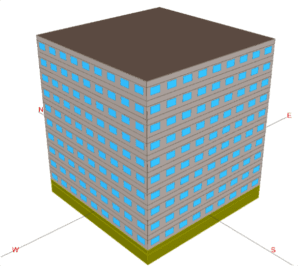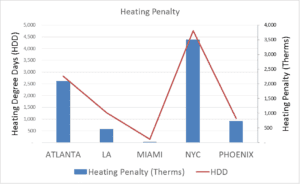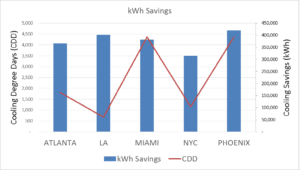
What Are Degree Days?
Degree days measure how warm or cold a location is. To calculate degree days, you compare the average of the high and low outdoor temperatures recorded for a specific area to a standard indoor temperature setpoint. In the United States, the standard temperature is often set at 65° Fahrenheit (F). The higher the outside temperature is, the more degree days an area will have. The more degree days that an area has, the more energy consumption they use to maintain a comfortable indoor temperature.
Cooling Degree Days and Heating Degree Days
There are two types of degree days: heating degree days (HDD) and cooling degree days (CDD). Heating degree days are a measurement of how cold the temperature was on a certain day or over a period of time. For example, if you had a day with an average temperature of 40°F, that would equate to 25 HDD if the desired indoor temperature is 65°F. Now, if you had two days in a row at that temperature, your number would double to 50 HDD.
Cooling degree days measure how warm the temperature of an area was on a certain day or series of days. If the given day you are recording data from has a mean temperature of 80°F, it would equal 15 CDD. Let’s say the following day had a mean temperature of 85°F. That would increase the CDD to 20. Then, the total CDD for those two days would be 35 CDD. Catching on?
Measuring Window Film Efficacy with Degree Days
Can degree days be used to determine where window film efficiency should be considered? If so, how many CDD are ‘enough’ to justify the consideration of window film? Also, what about the heating penalty from window film and the HDD for the location under consideration? Considering a building shell-like in Figure 1, are there enough CDD to see a location like Sacramento benefit, where the CDD is relatively low? What about New York City, where HDD is four times the amount of CDD – will that alone make it a bad candidate?

Typical Building Shell
HDD vs. CDD
When considering HDD, Figure 2 below shows significantly similar results between HDD and eQuest heating penalty. This means, as one would expect, in cities where significant space heating is required, the application of solar control window film produces a proportional heating penalty. In this case, HDD was a good predictor of the heating penalty for this data set.

HDD and Heating Penalty
But what about CDD? Does CDD correlate well with cooling (kWh) savings? As shown in Figure 3 below, CDD does not correlate well with simulated savings from eQuest.

CDD and Cooling Savings
Heating Loss and Cooling Savings Data Analysis
This small data set is enough to show that CDD cannot predict cooling savings. What also cannot be concluded from this data is why HDD has a better correlation to heating penalties than CDD has with cooling savings, although there are some reasonable possibilities:
- In winter, a large part of heating losses is conduction, and HDD is related to conduction since conduction is proportional to delta-T between inside and outside.
- Cooling savings is complex because, in addition to conductive heat transfer (like HDD), we have to consider radiative heat transfer (solar radiation) in cooling when the sun angle and solar heat gain are high.
The Missing Link: The Solar Heat Gain Coefficient
While the HDD proved to be fairly accurate in measuring heating penalties above, the CDD was not as accurate in measuring cooling savings. To measure your window film efficiency accurately, you need to utilize other resources beyond degree days. A proper energy reading needs to include the solar heat gain coefficient (SHGC).
The SHGC is the portion of solar radiation transferred through a window, door, skylight, etc. The lower your SHGC measurement is, the less solar heat is being transmitted into your building. Cooling savings are influenced by the amount of solar radiation they’re exposed to, so the SHGC is an excellent resource to compare your cooling savings with or without window film.
Using SHGC and whole-building energy simulation tools like eQuest are together (because of the impact of radiative heat transfer through solar radiation) a much more predictive data set when considering the improvement from application to window film than CDD.
Decrease Your Energy Consumption with NGS
If you’re interested in learning more about how sun control window film can improve your building’s energy efficiency, supply better occupant comfort, and create a polished exterior aesthetic, click here to check out our webinar.
Photo by Nastuh Abootalebi on Unsplash


